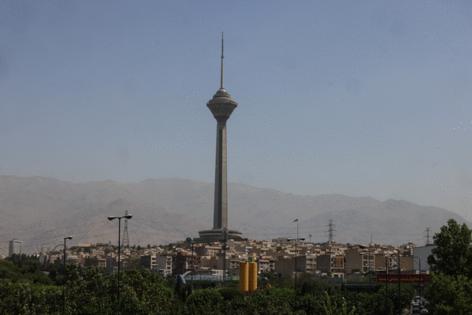Early assessment says Iran's nuclear sites damaged but not destroyed
Published in News & Features
BEIRUT — An initial damage assessment by the Pentagon said U.S. military strikes over the weekend failed to fully destroy Iranian nuclear sites, and that Iran’s nuclear program had suffered a setback that amounted to a few months.
The Defense Intelligence Agency’s classified report, which was first reported by CNN, casts doubt on the narrative President Donald Trump and his officials have repeated since the B-2 bombers hit Iranian nuclear installations in Natanz, Fordo and Isfahan that, according to Trump, were “completely and totally obliterated.”
On Tuesday, Trump insisted yet again that Iran would not be able to salvage anything of its nuclear program. “That place is under rock,” he said. “That place is demolished.”
Trump administration officials acknowledged the assessment’s existence but pooh-poohed its findings, with White House Press Secretary Karoline Leavitt saying in a statement it was “flat-out wrong.”
The damage assessment came the same day Trump excoriated both Israel and Iran over what he said were violations of the surprise ceasefire between the two nations that was set to begin Tuesday morning.
“We have two countries that have been fighting for so hard and so long that they don’t know what the f--- they are doing,” said an enraged Trump before leaving Washington for the NATO summit in Europe.
In the days since U.S. forces pummeled Iranian nuclear sites with “bunker buster” bombs, Iranian officials have downplayed the attack, insisting that the damage was mostly surface level and that, in any case, the country’s nuclear know-how remains intact.
The U.S. and Israel “should know that this industry has roots in our country, and the roots of this national industry cannot be destroyed,” said Behrouz Kamalvandi, spokesman of the Atomic Energy Organization of Iran, according to the semiofficial Tasnim News Agency on Sunday.
“Of course, we have suffered some losses, but this is not the first time that the industry has suffered damage. ... Naturally, this industry must continue, and its growth will not stop,” Kamalvandi said.
Ahead of the strikes, there was little consensus in the defense community as to whether the United States’ Massive Ordnance Penetrators — 30,000-pound bombs that can only be delivered by the B-2 bomber — could wipe out Fordo, a facility buried almost 300 feet under a mountain. Such bombs, weapons experts say, use their sheer weight to drill as far down as 200 feet before exploding. Multiple bombs can hit the same point, penetrating deeper with each missile, a technique one expert described as “digging with bombs.”
Other observers say Iran had transported much of the uranium at Fordo, its main uranium enrichment center, off site ahead of the strikes. A day after the U.S. strikes, Israel struck Fordo once more, hitting access roads leading to the facility.
Experts estimate that Iran still has no less than 19,800 pounds of uranium enriched at levels between 2% and 60%. The International Atomic Energy Agency will still have to account for the whereabouts of that uranium.
“One of the big questions is the status of Iran’s stockpiles of enriched material, since this is what it would use to feed into an enrichment site to produce weapons-grade plutonium,” said Eric Brewer, deputy vice president of the Nuclear Materials Security Program for Nuclear Threat Initiative, a Washington think tank.
“It’s entirely unclear where these are today because they could be used to construct a covert facility,” Brewer said.
Tehran insists it wants nuclear power for peaceful purposes, and U.S. intelligence assessments before the war said it was not working toward weaponization — a view Trump contradicted. Even if a bomb was a goal, experts say, it would take months to enrich uranium to weapons-grade, and Iran would still need more time to package it in a missile.
Israel has for years accused Iran of running a clandestine nuclear weapons program, and Israeli Prime Minister Benjamin Netanyahu has repeatedly warned an Iranian bomb was imminent.
Netanyahu launched a devastating campaign June 13 in a bid to destroy Iran’s nuclear facilities and ballistic missile arsenal and to kill key military leaders.
The leak of the initial damage assessment was the work of “an anonymous, low-level loser in the intelligence community,” Leavitt said.
“The leaking of this alleged assessment,” she added, “is a clear attempt to demean President Trump, and discredit the brave fighter pilots who conducted a perfectly executed mission to obliterate Iran’s nuclear program. Everyone knows what happens when you drop 14 30,000-pound bombs perfectly on their targets: total obliteration.”
The state of Iran’s nuclear program is likely to be a pivotal issue for whether a shaky ceasefire brokered by Trump and Qatar’s leadership early Tuesday would hold.
The details of the ceasefire — negotiated hours after a limited volley of Iranian ballistic missiles targeted the United States’ Al Udeid Air Base on Monday — remain unclear, but it spurred cautious optimism across the Middle East.
Its fragility was emphasized when Israel accused Iran of breaking the agreement mere hours after it was supposed to take effect, with the Israeli military saying it intercepted a pair of ballistic missiles fired from Iran and that it would respond.
Iran’s chief of the General Staff of the Armed Forces, Abdolrahim Mousavi, denied any launch after the truce’s beginning, according to Iranian official media. A later statement by the Islamic Revolutionary Guard Corps said 14 missiles were fired “in the last minutes” before the ceasefire.
A visibly enraged Trump castigated both sides for the violations, saying he was not happy with either country. “These guys gotta calm down,” he said.
Later, he took to his Truth Social platform to tell Israel to “BRING YOUR PILOTS HOME, NOW!”
Israeli officials later told reporters that warplanes carried out a small strike against an Iranian radar north of Tehran around the time Trump was talking to reporters.
A statement from Neyanyahu’s office said: “Following President Trump’s conversation with Prime Minister Netanyahu, Israel refrained from additional attacks.”
Iran’s Supreme National Security Council, the governmental body in charge of military affairs, took a similarly triumphant tone in its statement agreeing to the ceasefire, saying that Iran’s victory “forced the enemy to regret and accept defeat and unilaterally halt its attack.”
It added, however, that Iranian forces will remain “with their hands on the trigger.”
Iran’s attacks on Israel killed 28 people and wounded more than 1,000 others, including the victims of Tuesday’s strike. Israel’s campaign on Iran killed 610 people and wounded 4,746 since the war began, according to Iran’s health ministry.
That a ceasefire was brokered at all came as a surprise. In the hours before Trump’s announcement, Iran lobbed missiles at the Al Udeid Air Base in Qatar, the largest U.S. military installation in the region with some 10,000 U.S. troops and its Central Command headquarters.
But although it initially triggered fears of a rapid expansion of the conflict, Iran’s attack proved to be relatively subdued, less the “mighty and powerful response” it vowed before the barrage than a pre-choreographed, face-saving gesture designed to be largely symbolic. Trump said Monday that Iran had actually warned the U.S. of the attack in advance.
Qatar said the attack was a “flagrant violation” of its sovereignty and airspace, and promised it would respond in an appropriate manner. Instead, in a measure of the urgency felt by Persian Gulf nations to prevent a wider conflagration, the Qatari emir, Tamim bin Hamad Al Thani, and Prime Minister Mohammed bin Abdulrahman Al Thani coordinated with Trump and Vice President JD Vance to end the hostilities, according to an official briefed on the talks and who requested anonymity to be able to speak freely.
In Tehran on Tuesday, there was a mood of tentative joy at the end of what had been a bruising couple of weeks for the capital. Still, many expressed the feeling of being betrayed by the international community.
“Iran was left with very few options,” said Venus Shahri, a 40-year-old teacher from Tehran.
Others said that although they were disappointed by the defensive capabilities of Iran’s army, they wanted to double down on the fight.
“We shouldn’t have accepted the ceasefire offer at all,” said Jaber Khadiri, 55. “We must have nuclear weapons. There’s no other choice.”
_____
©2025 Los Angeles Times. Visit at latimes.com. Distributed by Tribune Content Agency, LLC.







Comments